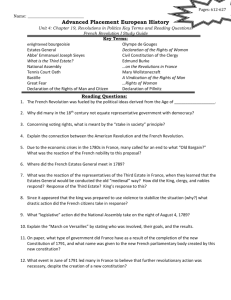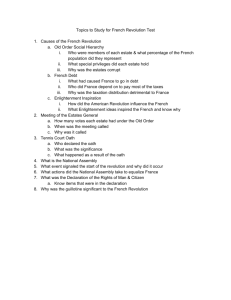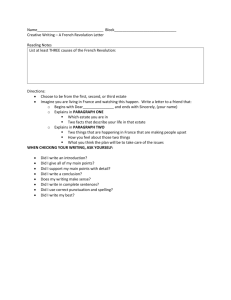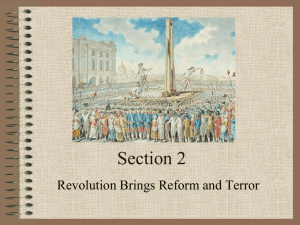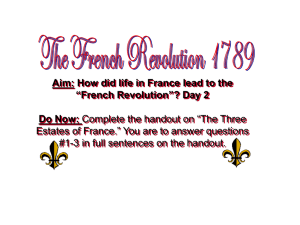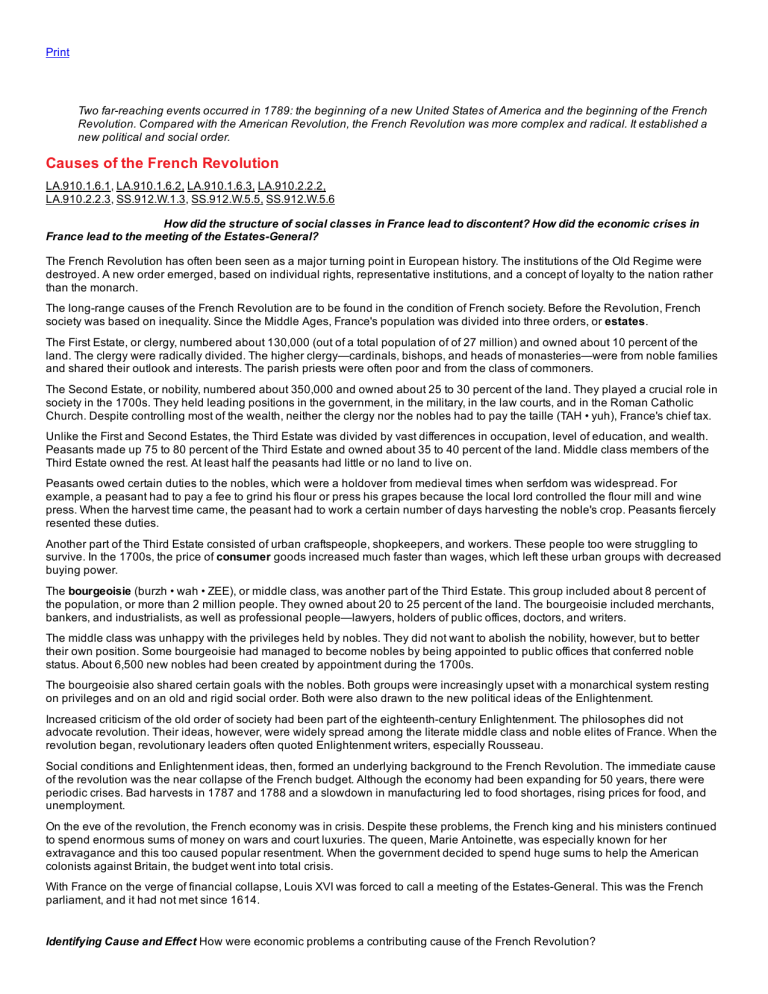
Print Two far­reaching events occurred in 1789: the beginning of a new United States of America and the beginning of the French Revolution. Compared with the American Revolution, the French Revolution was more complex and radical. It established a new political and social order. Causes of the French Revolution LA.910.1.6.1, LA.910.1.6.2, LA.910.1.6.3, LA.910.2.2.2, LA.910.2.2.3, SS.912.W.1.3, SS.912.W.5.5, SS.912.W.5.6 How did the structure of social classes in France lead to discontent? How did the economic crises in France lead to the meeting of the Estates­General? The French Revolution has often been seen as a major turning point in European history. The institutions of the Old Regime were destroyed. A new order emerged, based on individual rights, representative institutions, and a concept of loyalty to the nation rather than the monarch. The long­range causes of the French Revolution are to be found in the condition of French society. Before the Revolution, French society was based on inequality. Since the Middle Ages, France's population was divided into three orders, or estates. The First Estate, or clergy, numbered about 130,000 (out of a total population of of 27 million) and owned about 10 percent of the land. The clergy were radically divided. The higher clergy—cardinals, bishops, and heads of monasteries—were from noble families and shared their outlook and interests. The parish priests were often poor and from the class of commoners. The Second Estate, or nobility, numbered about 350,000 and owned about 25 to 30 percent of the land. They played a crucial role in society in the 1700s. They held leading positions in the government, in the military, in the law courts, and in the Roman Catholic Church. Despite controlling most of the wealth, neither the clergy nor the nobles had to pay the taille (TAH • yuh), France's chief tax. Unlike the First and Second Estates, the Third Estate was divided by vast differences in occupation, level of education, and wealth. Peasants made up 75 to 80 percent of the Third Estate and owned about 35 to 40 percent of the land. Middle class members of the Third Estate owned the rest. At least half the peasants had little or no land to live on. Peasants owed certain duties to the nobles, which were a holdover from medieval times when serfdom was widespread. For example, a peasant had to pay a fee to grind his flour or press his grapes because the local lord controlled the flour mill and wine press. When the harvest time came, the peasant had to work a certain number of days harvesting the noble's crop. Peasants fiercely resented these duties. Another part of the Third Estate consisted of urban craftspeople, shopkeepers, and workers. These people too were struggling to survive. In the 1700s, the price of consumer goods increased much faster than wages, which left these urban groups with decreased buying power. The bourgeoisie (burzh • wah • ZEE), or middle class, was another part of the Third Estate. This group included about 8 percent of the population, or more than 2 million people. They owned about 20 to 25 percent of the land. The bourgeoisie included merchants, bankers, and industrialists, as well as professional people—lawyers, holders of public offices, doctors, and writers. The middle class was unhappy with the privileges held by nobles. They did not want to abolish the nobility, however, but to better their own position. Some bourgeoisie had managed to become nobles by being appointed to public offices that conferred noble status. About 6,500 new nobles had been created by appointment during the 1700s. The bourgeoisie also shared certain goals with the nobles. Both groups were increasingly upset with a monarchical system resting on privileges and on an old and rigid social order. Both were also drawn to the new political ideas of the Enlightenment. Increased criticism of the old order of society had been part of the eighteenth­century Enlightenment. The philosophes did not advocate revolution. Their ideas, however, were widely spread among the literate middle class and noble elites of France. When the revolution began, revolutionary leaders often quoted Enlightenment writers, especially Rousseau. Social conditions and Enlightenment ideas, then, formed an underlying background to the French Revolution. The immediate cause of the revolution was the near collapse of the French budget. Although the economy had been expanding for 50 years, there were periodic crises. Bad harvests in 1787 and 1788 and a slowdown in manufacturing led to food shortages, rising prices for food, and unemployment. On the eve of the revolution, the French economy was in crisis. Despite these problems, the French king and his ministers continued to spend enormous sums of money on wars and court luxuries. The queen, Marie Antoinette, was especially known for her extravagance and this too caused popular resentment. When the government decided to spend huge sums to help the American colonists against Britain, the budget went into total crisis. With France on the verge of financial collapse, Louis XVI was forced to call a meeting of the Estates­General. This was the French parliament, and it had not met since 1614. Identifying Cause and Effect How were economic problems a contributing cause of the French Revolution? The National Assembly SS.912.H.1.3, SS.912.W.1.3, SS.912.W.5.6 Why did the Third Estate declare itself to be the National Assembly? What were the French peasants reacting to in their rebellions of 1789? Louis XVI called a meeting of the Estates­General at Versailles on May 5, 1789. In the Estates­General, the First and Second Estates each had about 300 representatives. The Third Estate had almost 600 representatives. Most of the Third Estate wanted to set up a constitutional government that would make the clergy and nobility pay taxes, too. From the start, there were arguments about voting. Traditionally, each estate had one vote—the First and Second Estates could outvote the Third Estate two to one. The Third Estate demanded instead that each deputy have one vote. Under this new system, with the help of a few nobles and clerics, the Third Estate would then have a majority vote. The king, however, stated that he favored the current system. On June 17, 1789, the Third Estate boldly declared that it was the National Assembly and would draft a constitution. Three days later, on June 20, its deputies arrived at their meeting place, only to find the doors had been locked. They then moved to a nearby indoor tennis court and swore that they would continue meeting until they had a new constitution. The oath they swore is known as the Tennis Court Oath. Louis XVI prepared to use force against the Third Estate. On July 14, 1789, about 900 Parisians gathered in the courtyard of the Bastille (ba • STEEL)—an old fortress used as a prison and armory. They stormed the Bastille, and after four hours of fighting, the prison warden surrendered. The rebels cut off the warden's head and demolished the Bastille brick by brick. Paris was abandoned to the rebels. When King Louis XVI returned to his palace at Versailles after a day of hunting, the duc de la Rochefoucauld­Liancourt told him about the fall of the Bastille. Louis is said to have exclaimed, "Why, this is a revolt." "No, Sire," replied the duke. "It is a revolution." Louis XVI was informed that he could no longer trust royal troops to shoot at the mob. The king's authority had collapsed in Paris. Meanwhile, all over France, revolts were breaking out. Popular hatred of the entire landholding system, with its fees and obligations, had finally spilled over into action. Peasant rebellions became part of the vast panic known as the Great Fear. Rumors spread from village to village that foreign troops were on the way to put down the revolution. The peasants reacted by breaking into the houses of the lords to destroy the records of their obligations. Making Connections What was the connection between the actions of the representatives of the Third Estate and the Estates­ General and those of the peasants during the Great Fear? Analyzing PRIMARY SOURCES Declaration of the Rights of Man and the Citizen 1. Men are born and remain free and equal in rights; social distinctions can be established only for the common benefit. 7. No man can be accused, arrested, or detained except in cases determined by the law, and according to the forms which it has prescribed… 10. No one may be disturbed because of his opinions, even religious, provided that their public demonstration does not disturb the public order established by law." —from the Declaration of the Rights of Man and the Citizen, 1789 DBQ IDENTIFYING How does this document reflect Enlightenment thought? End of the Old Regime SS.912.W.1.3, SS.912.W.5.5, SS.912.W.5.6 How did the French Revolution enter a new phase after the storming of the Bastille? The National Assembly reacted to news of peasant rebellions and rumors of a possible foreign invasion. On August 4, 1789, the National Assembly voted to abolish all legal privileges of the nobles and clergy. Declaration of the Rights of Man On August 26, the National Assembly adopted the Declaration of the Rights of Man and the Citizen. Inspired by the English Bill of Rights of 1689 and by the American Declaration of Independence and Constitution, this charter of basic liberties began with "the natural and imprescriptible rights of man" to "liberty, property, security, and resistance to oppression." Reflecting Enlightenment thought, the declaration proclaimed that all men were free and equal before the law, that appointment to public office should be based on talent, and that no group should be exempt from taxation. Freedom of speech and of the press were affirmed. The declaration raised an important issue. Should equal rights include women? Many deputies agreed, provided that, as one man said, "women do not [hope] to exercise political rights and functions." One writer, Olympe de Gouges, refused to accept this exclusion of women. Echoing the words of the official declaration, she wrote: Believing that ignorance, omission, or scorn for the rights of woman are the only causes of public misfortunes and of the corruption of governments, the women have resolved to set forth in a solemn declaration the natural, inalienable, and sacred rights of woman in order that this declaration, constantly exposed before all the members of the society, will ceaselessly remind them of their rights and duties. —from Declaration of the Rights of Woman and the Female Citizen, 1791 The King Concedes In the meantime, Louis XVI remained quiet at Versailles. He refused to accept the National Assembly's decrees. On October 5, thousands of Parisian women armed with broomsticks, pitchforks, pistols, and other weapons marched to Versailles. Some of the women then met with the king. They told him that their children were starving because there was no bread. These women forced Louis to accept the new decrees. The crowd insisted that the royal family return to Paris. On October 6, they did so. As a goodwill gesture, they carried wagonloads of flour from the palace storehouse. They were escorted by women who chanted: "We are bringing back the baker, the baker's wife, and the baker's boy." The king, the queen, and their son were now virtual prisoners in Paris. Church Reforms Under the old regime, the Catholic Church had been an important pillar of the old order. The revolutionaries felt they had to reform it, too. The new revolutionary government had another serious motivation, however: the need for money. By seizing and selling off Church lands, the National Assembly was able to increase the state's revenues. Finally, the Church was formally brought under the control of the state. A new Civil Constitution of the Clergy said that bishops and priests were to be elected by the people, not appointed by the pope and the Church hierarchy. The state would also pay the salaries of the bishops and priests. Because of these changes, many Catholics became enemies of the revolution. New Constitution and New Fears The new Constitution of 1791 set up a limited monarchy. There was still a king, but a Legislative Assembly would make the laws. The Legislative Assembly was to consist of 745 representatives chosen in such a way that only the more affluent members of society would be elected. By 1791, the old order had been destroyed, but the new government did not have universal support. Political radicals wanted more reform. The king detested the new order and his loss of absolute power. In June 1791, the royal family attempted to flee France in disguise. They almost succeeded but were recognized, captured, and brought back to Paris. In this unsettled situation, the new Legislative Assembly first met in October 1791. France's relations with the rest of Europe soon led to the king's downfall. War With Austria Over time, some European leaders began to fear that revolution would spread to their countries. The kings of Austria and Prussia even threatened to use force to restore Louis XVI to full power. Insulted by this threat and fearing attack, the Legislative Assembly decided to strike first, declaring war on Austria in the spring of 1792. The French fared badly in the initial fighting. A frantic search for scapegoats began. One observer in France noted: Everywhere you hear the cry that the king is betraying us, the generals are betraying us, that nobody is to be trusted; . . . that Paris will be taken in six weeks by the Austrians. . . . We are on a volcano ready to spout flames — quoted in The Oxford History of the French Revolution Rise of the Paris Commune In the spring of 1792, angry citizens demonstrated to protest food shortages and defeats in the war. In August, Paris radicals again decided the fate of the revolution. They declared themselves a commune—a popularly run city council—and attacked the royal palace and Legislative Assembly. The French Revolution was entering a more radical and violent stage. Members of the new Paris Commune took the king captive. They forced the Legislative Assembly to suspend the monarchy and to call for a National Convention. This time they wanted a more radical change. All the representatives who would decide the nation's future would be elected through universal male suffrage, in which all adult males had the right to vote. This would broaden the group of voters to include men who did not meet the initial standards for citizenship established by the Assembly. Many members of the Paris Commune proudly called themselves sans­culottes, meaning "without breeches." Wearing long trousers, not the knee­length breeches of the nobles, they identified themselves as ordinary patriots. Often, sans­culottes are depicted as poor workers, but many were merchants or artisans—the elite of their neighborhoods. Analyzing In what ways did the end of the old order move the revolution toward a more radical phase? Reviewing Vocabulary 1. Describing Write a paragraph describing all the types of people who made up the French bourgeoisie. Be sure to explain how people within this class might have different points of view about the French government. LA.910.1.6.1, LA.910.2.2.2, SS.912.W.5.5 Using Your Notes 2. Comparing and Contrasting Use your notes on the long­range and immediate causes of the French Revolution to compare and contrast one long­range and one immediate cause of the French Revolution. LA.910.1.6.1, LA.910.2.2.2, LA.910.2.2.3, SS.912.W.5.5, SS.912.W.5.6 Answering the Guiding Questions 3. Evaluating How did the structure of social classes in France lead to discontent? LA.910.1.6.1, LA.910.2.2.2, SS.912.W.5.5, SS.912.W.5.6 4. Identifying Central Issues How did the economic crises in France lead to the meeting of the Estates­General? LA.910.1.6.1, LA.910.2.2.2, SS.912.W.5.6 5. Drawing Conclusions Why did the Third Estate declare itself to be the National Assembly? LA.910.1.6.1, LA.910.2.2.2, SS.912.W.5.6 6. Making Connections What were the French peasants reacting to in their rebellions of 1789? LA.910.2.2.2, SS.912.W.5.6 7. Theorizing How did the French Revolution enter a new phase after the storming of the Bastille? LA.910.2.2.2, SS.912.W.5.6 Writing Activity 8. EXPOSITORY Write an essay exploring the influences on the Declaration of the Rights of Man and the Citizen. Be sure to include a discussion of influential documents from other countries. Also discuss influences specific to France, identifying cultural, political, and economic concerns the authors wanted to address. LA.910.2.2.2, SS.912.W.5.5, SS.912.W.5.6

